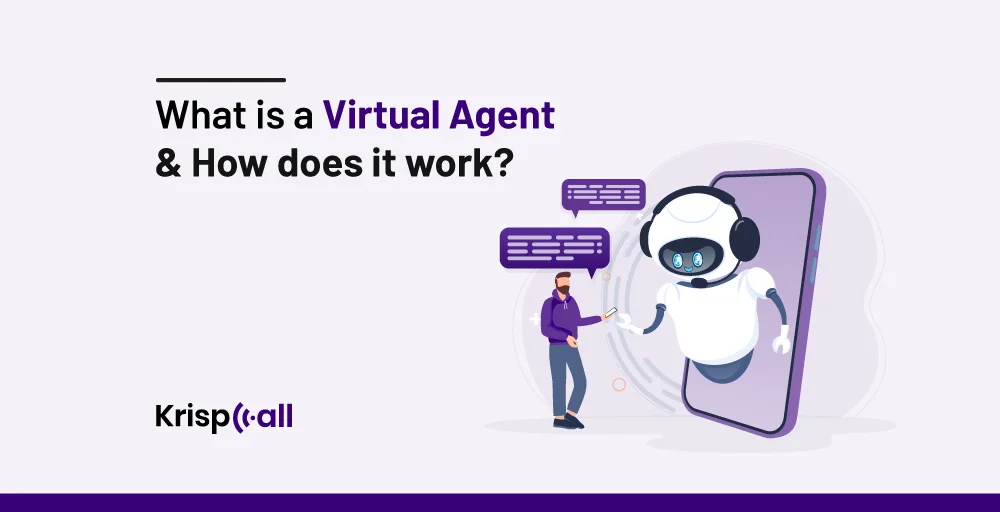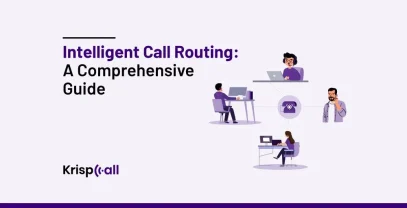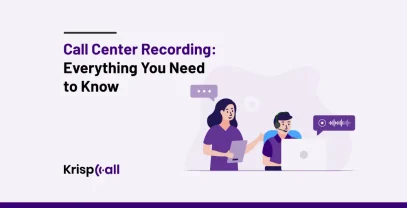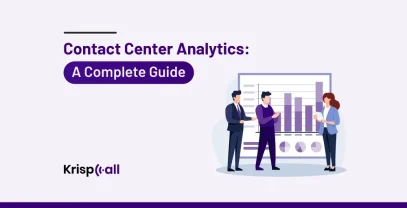Feeling overwhelmed😰 by a constant stream of customer calls? Does your business face the challenge of meeting customer demands for instant assistance and personalized support❓
If you’re nodding your head, then virtual agents might be the solution you’ve been searching for. But how exactly can they help, and are they right for your company?
In this blog post, we’ll dive into the world of virtual agents, exploring their capabilities and the benefits they can offer for businesses in today’s fast-paced world.
What is a virtual agent?
A virtual agent is a computer program or application created to imitate human interaction and offer assistance or information to users. These agents can use text-based communication, voice recognition technology, or a mix of both, depending on the platform and user preferences.
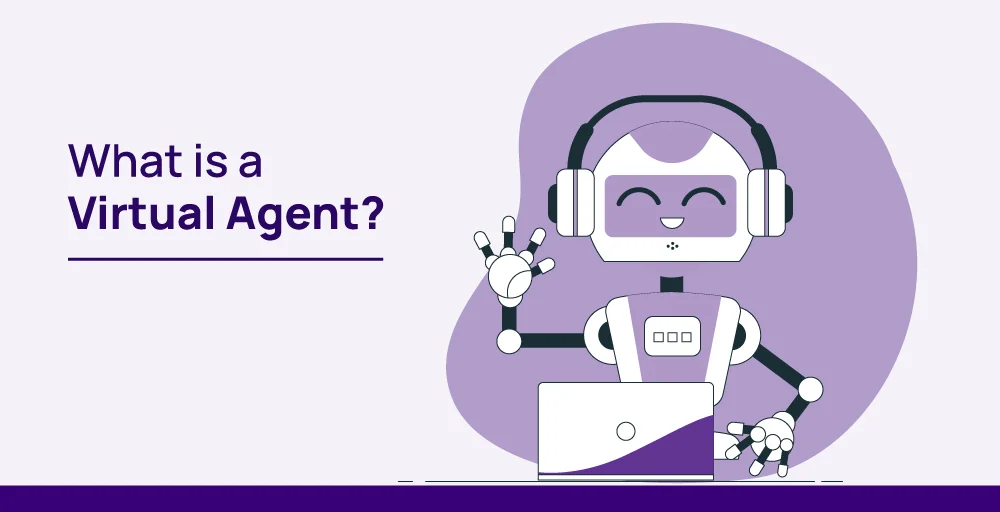
In customer service settings, virtual agents often manage inquiries, provide support, and assist users through processes without direct human involvement. They utilize predefined scripts, decision trees, or machine learning algorithms to understand user queries and deliver suitable responses promptly, improving user experiences and simplifying communication channels.
In general, virtual agents significantly contribute to automating routine tasks, enhancing accessibility, and boosting efficiency in businesses across various industries and applications.
How does virtual agent work?
To understand how virtual agents work, we need to know that the talk about virtual agents started in the 1950s and 1960s. The real-world application for virtual agent technologies initially emerged in the early 2000s. Where advancements in NLP, machine learning, and computing power paved the way for virtual agents.
Organizations develop virtual agents to manage specific human requests within predetermined workflows. These agents followed scripted responses tailored to individual inquiries, recognizing keywords to provide appropriate replies.
Virtual agents primarily handled routine tasks, transferring more complex interactions to human agents when necessary or when inquiries deviated from scripted parameters.
Eventually, the organization began to develop virtual agents by leveraging a combination of technologies to understand user queries, retrieve information, and complete tasks.
Here is a breakdown of how virtual agents function:
- User Initiation: Users can communicate with the virtual agent using a chat window, voice instructions, or text messages.
- Input Processing: Natural Language Processing (NLP) analyzes the user’s questions, and requests to understand the intent or meaning. It works by identifying keywords & phrases and analyzing sentence structure & grammar.
- Knowledge Base Access: The virtual agent searches its internal knowledge base for information. The database contains FAQs, company policies and guidelines, product details and specifications, and even troubleshooting procedures.
- Response Generation: By extracting meaning and information, the virtual agents forward responses such as voice-synthesized answers, scheduling appointments, and textual responses displayed in a chat window.
- Conversation Management: The virtual agents can track your conversation topic, follow the pre-defined workflow or decision trees, and guide the user toward a resolution, keeping track of the conversation topic, and providing clarification to users.
- Machine Learning: Virtual agents have the capability of machine learning they can analyze past interactions to improve the accuracy of their responses, identify patterns, and adapt to new situations.
- Speech Recognition: Virtual agents designed for voice interaction utilize speech recognition technology. This allows them to convert spoken words into text for NLP processing.
How to use a virtual agent?
To use a virtual agent software for your business from a cloud service provider or software vendor must allocate resources for training the virtual agent, which may include methods like providing it with information from a knowledge base.
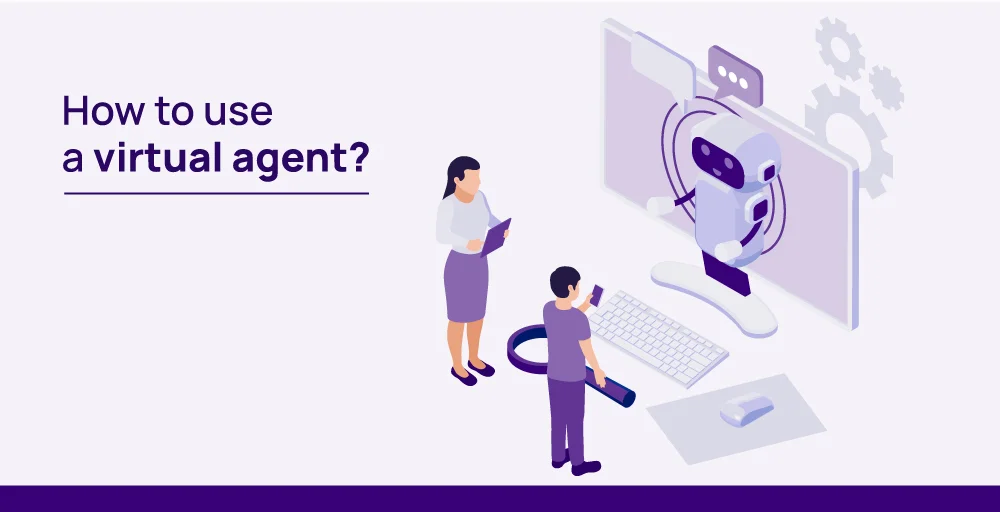
You need to remember that virtual agents rely on the information provided to the AI system. Inaccurate❌ data within the system can lead to misinformation for customers. Hence, the setup phase is critical. Though it demands an initial investment of time, it’s worthwhile as it decreases call volumes, allows live agents to tackle more intricate customer service tasks, and enhances the overall customer experience.
Here’s how you can use a virtual agent based on practical steps:
Finding a virtual agent
Businesses incorporate virtual agents into their websites, featuring chat windows or pop-up icons labeled “Chat with Us,” “Help,” or “Customer Support.” They also include them in mobile apps, typically accessible in menus or settings, assisting while users are on the move.
Moreover, companies use virtual agents on social media platforms, indicated by message buttons or direct message options on their profiles.
Interacting with a virtual agent
Engaging with virtual agents provides users with various ways to interact. The main method involves text chat, where users type questions or requests to clarify. Certain agents also allow voice commands triggered by wake words such as “Hey Google” or “Alexa,” although they have limited functionalities.
Users can verify voice command availability in settings. Furthermore, agents may present buttons for easier inquiries or decision-making processes.
Using a virtual agent effectively
When you’re interacting with virtual agents, begin with straightforward questions like FAQs or simple troubleshooting. They might struggle with complex problems. Adding relevant keywords to your queries helps them grasp your question and give better answers.
Also, watch for step-by-step guidance some agents provide, and follow their on-screen prompts or instructions carefully for effective help.
For example, IBM’s Watson Assistant is trained to understand common customer support requests in the many ways customers ask questions. And, as with any software-as-a-service platform, Watson Virtual Agent doesn’t require installation, and improvements are added automatically.
Virtual agent vs. chatbot vs. virtual assistant
The terms virtual agent, chatbot, and virtual assistant are often interrelated🔁 with one another and are often said to be the same. But did you know that each of the terms has its own meaning and is used for a separate purpose? Well, let’s break it down into different parts and find out here:
Virtual agent vs Chatbot
| Based On | Virtual Agent | Chatbot |
| Scope and Functionality | Virtual agent is the broadest term for chatbots. It is a software program that replicates conversations of humans, offering customer service, information retrieval, or task automation. | Chatbot is a specific type of virtual agent designed for a more limited range of interactions. It focuses on FAQs, providing basic troubleshooting steps, or qualifying leads. |
| Capabilities and Learning | Basic virtual agents might rely on pre-programmed responses and decision trees. More advanced utilize natural language processing (NLP) and machine learning to learn and improve over time. | Typically relies on scripted responses and keywords. It might not have the ability to learn or adapt its responses based on past interactions. |
| Level of Personalization | It can offer basic personalization features like remembering the past interactions or addressing users by name. | Offers minimal personalization. Interactions are usually scripted and don’t adapt to individual users. |
| Examples | The automated chat window on a bank’s website that answers basic account questions or guides users through online transactions. | A program on a clothing retailer’s website that helps users find specific items based on size, color, or style preferences. |
Virtual agent vs Virtual assistant
| Based On | Virtual Agent | Virtual Assistant |
| Scope and Functionality | Virtual agent is the broadest term for virtual assistants. | A virtual assistant is a more advanced virtual agent that acts as a personal assistant. It can manage tasks like scheduling appointments, booking travel, or controlling smart home devices. |
| Capabilities and Learning | Capabilities can vary as basic agents use pre-programmed responses while in advanced ones machine learning and NLP are used. | Highly focused on personalized experiences. Learns user preferences, habits, and context to anticipate needs. Integrates with various tools and services for a holistic experience |
| Level of Personalization | Highly focused on personalized experiences. Learns user preferences, habits, and context to anticipate needs. Integrates with various tools and services for a holistic experience | Offers a highly personalized experience tailored to the individual user. Learns preferences, routines, and adapts responses accordingly. Proactive in suggesting actions based on user needs and context. |
| Examples | Website chatbot answering FAQs, about products or services, voice assistant providing weather updates or directions. | Smart speakers like Amazon Alexa or Google Assistant can manage to-do lists, set reminders, control smart home devices, or book appointments. |
What are the common types of virtual agents?
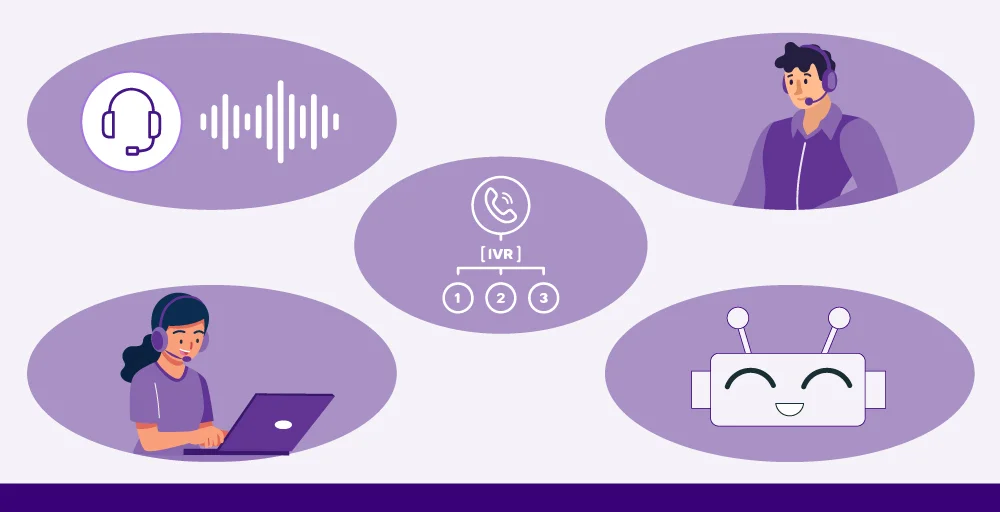
In the recent market, multiple types of virtual agents have been introduced, that promise to upscale📈 your everyday tasks in business. By filtering and considering here are some of the important virtual agents that are mostly heard and used in businesses:
- Chatbots: Chatbots🤖 are virtual agents that interact with users through text. These bots are used to assist, answer your questions, and facilitate transactions via typed messages mostly in websites, messaging platforms, and mobile apps.
- Voice bots (Virtual Voice Agents): Virtual Voice Agents, also called voice bots, interact with users using speech recognition technology. They respond to your verbal commands, allowing text-free communication in applications.
- IVR system: IVR (Interactive Voice Response) systems, are used via voice and keypad inputs in an automated telephony system. You can mostly find IVR in customer service settings to route calls, pre-recorded information, and enable self-service transactions.
- IVA/AI agents: Intelligent Virtual Agents (IVA) or AI agents possess AI capabilities to understand and respond intelligently to user queries. They analyze natural language input, learn from interactions, and offer personalized responses, thus providing a higher level of assistance and efficiency compared to traditional scripted bots.
- Hybrid solutions: Hybrid solutions leverage the strengths of various types of virtual agents at once. They integrate chatbots, voice bots, IVR systems, and AI agents, offering you multiple interaction channels including text-based messaging, voice communication, and interactive phone menus. This ensures flexibility and efficiency in addressing diverse user needs and preferences.
What are the benefits of implementing virtual agent software?
With virtual agent software, you can undoubtedly enhance your business’s daily performance. There are certain sectors in which the benefits of implementing virtual agent software can be seen such as
1. Improved customer service
Implementing virtual agent software on your website ensures 24/7 availability, instant responses to basic inquiries, and resolution of common issues even when you’re unavailable. Meanwhile, human agents can address more complex issues, enhancing overall customer satisfaction.
2. Increased efficiency and cost savings
You can automate repetitive tasks using virtual agent software, which reduces the workload of human agents who answer FAQs, schedule appointments, and process small orders. This results in cost savings and enables your human agent to focus on higher-value activities.
3. Enhanced lead generation and qualification
Virtual agents can engage website visitors, answer sales-related questions, and capture lead information. This allows you to qualify leads more effectively and convert website traffic into potential customers.
4. Personalized interactions at scale
Virtual agents can personalize interactions based on user data, providing a more engaging experience. They can recommend products or services relevant to individual needs and answer questions in a tailored manner.
5. Improved data collection and analysis
Virtual agents gather valuable data from customer interactions, including frequently asked questions and areas of confusion. You can use this data to analyze calls from your virtual agent’s responses and gain insights into customer behavior.
6. Scalability and availability
Virtual agents handle a high volume of inquiries simultaneously and ensure consistent support regardless of peak traffic times. This is particularly beneficial for businesses operating across multiple time zones.
Virtual agent use case
The virtual agent has been used in almost every platform in recent days as it is much easier to automate repetitive activities. Some of the main sectors in which virtual agents are used are listed below:
Customer service
Virtual agents provide comprehensive customer service for businesses, offering 24/7 support by addressing inquiries, troubleshooting issues, and guiding users to resources.
They also aid in lead generation by engaging website visitors, qualifying leads, and scheduling appointments. Additionally, they streamline order tracking and support processes, assisting customers with orders and resolving related issues.
Human resources
Virtual assistants play a vital role in managing human resources. They screen applicants, guide new hires through onboarding, and offer internal support. This includes managing candidate screenings, scheduling interviews, addressing job inquiries, assisting with onboarding, explaining company policies and benefits, and granting resource access.
Furthermore, they help employees with tasks like password resets, IT support, and booking conference rooms.
Marketing and sales
Virtual agents improve customer engagement and boost sales by offering personalized product recommendations tailored to customer data. They interact with website visitors to gather lead information and respond to sales-related queries.
Additionally, they play a crucial role in executing marketing campaigns, disseminating promotional offers, and handling customer inquiries regarding promotions.
Telecommunication
Virtual agents improve the telecommunications industry by providing cost-effective methods to enhance customer experience. According to a Genesys study, 67% of customers anticipate self-service options. Virtual agents meet this demand by offering 24/7 support and addressing common questions regarding billing, plans, and basic technical concerns.
This decreases the workload of call centers, enabling human agents to tackle more intricate inquiries, while also granting customers the autonomy to manage their accounts autonomously, ultimately leading to higher satisfaction levels.
Set up Remote Call Center Business with KrispCall Virtual Call Center
Although not a complete virtual agent, KrispCall provides a wide range of telephony features that can greatly enhance your call center’s automation. It utilizes pre-recorded greetings and outbound calls to improve efficiency.
You can create customized greetings for various scenarios, inform callers about business hours, or provide basic troubleshooting guidance. With KrispCall’s outbound call center feature, you can send appointment reminders or follow-up calls using pre-recorded messages, which saves both time and resources.
KrispCall’s IVR system improves automation by enabling users to design a multi-layered menu with voice prompts, facilitating navigation to relevant departments or voicemail boxes. Integrating your CRM with KrispCall allows access to customer history for personalized interactions.
KrispCall provides features that automate basic interactions, enhance customer experience, and allow live agents to focus on more complex issues. It serves as a stepping stone toward a more virtualized call center experience.
Conclusion
Virtual agents have become essential tools across various industries, transforming customer service and improving effectiveness. Utilizing advanced technologies like artificial intelligence and machine learning, virtual agents offer continuous support, personalized aid, and efficient communication.
Moreover, telephony solutions such as KrispCall are vital for integrating virtual agents into current systems and facilitating smooth communication between businesses and their clients. As companies prioritize customer satisfaction and operational efficiency, the utilization of virtual agents, alongside telephony solutions like KrispCall, will undoubtedly continue to be fundamental in achieving these goals in the digital era.
For more sign up for KrispCall today or you can try a free demo as well!
FAQ
What can an AI virtual agent do?
- Handle repeatable customer interactions
- Recognize natural language and understand customer intent
- Speak using a human-sounding text-to-speech engine or a prerecorded voice
- Route advanced interactions to live agents in a way that’s convenient to the customer
What are some of the challenges and limitations of virtual agents?
The challenges and limitations of virtual agents are language understanding, complex Query handling, and lack of emotional intelligence.
What are the future trends in virtual agents?
The future trends of virtual agents look promising, with trends such as integration with augmented reality, enhanced personalization, and advanced natural language processing on the horizon.

